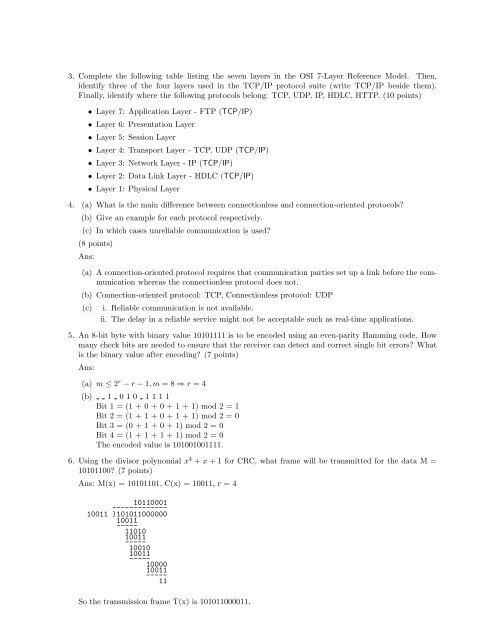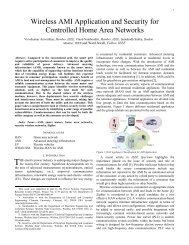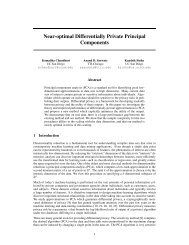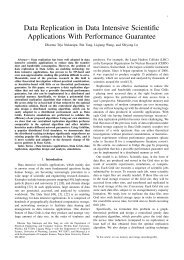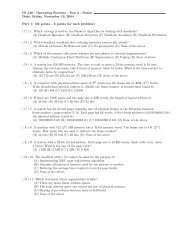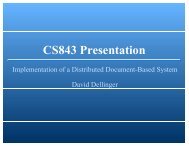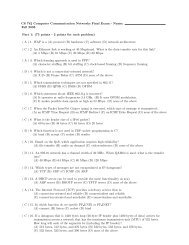CS 742 Computer Communication Networks Exam 1 - Name: Fall ...
CS 742 Computer Communication Networks Exam 1 - Name: Fall ...
CS 742 Computer Communication Networks Exam 1 - Name: Fall ...
You also want an ePaper? Increase the reach of your titles
YUMPU automatically turns print PDFs into web optimized ePapers that Google loves.
3. Complete the following table listing the seven layers in the OSI 7-Layer Reference Model. Then,<br />
identify three of the four layers used in the TCP/IP protocol suite (write TCP/IP beside them).<br />
Finally, identify where the following protocols belong: TCP, UDP, IP, HDLC, HTTP. (10 points)<br />
• Layer 7: Application Layer - FTP (TCP/IP)<br />
• Layer 6: Presentation Layer<br />
• Layer 5: Session Layer<br />
• Layer 4: Transport Layer - TCP, UDP (TCP/IP)<br />
• Layer 3: Network Layer - IP (TCP/IP)<br />
• Layer 2: Data Link Layer - HDLC (TCP/IP)<br />
• Layer 1: Physical Layer<br />
4. (a) What is the main difference between connectionless and connection-oriented protocols?<br />
(b) Give an example for each protocol respectively.<br />
(c) In which cases unreliable communication is used?<br />
(8 points)<br />
Ans:<br />
(a) A connection-oriented protocol requires that communication parties set up a link before the communication<br />
whereas the connectionless protocol does not.<br />
(b) Connection-oriented protocol: TCP, Connectionless protocol: UDP<br />
(c)<br />
i. Reliable communication is not available.<br />
ii. The delay in a reliable service might not be acceptable such as real-time applications.<br />
5. An 8-bit byte with binary value 10101111 is to be encoded using an even-parity Hamming code. How<br />
many check bits are needed to ensure that the receiver can detect and correct single bit errors? What<br />
is the binary value after encoding? (7 points)<br />
Ans:<br />
(a) m ≤ 2 r − r − 1, m = 8 ⇒ r = 4<br />
(b) 1 0 1 0 1 1 1 1<br />
Bit 1 = (1 + 0 + 0 + 1 + 1) mod 2 = 1<br />
Bit 2 = (1 + 1 + 0 + 1 + 1) mod 2 = 0<br />
Bit 3 = (0 + 1 + 0 + 1) mod 2 = 0<br />
Bit 4 = (1 + 1 + 1 + 1) mod 2 = 0<br />
The encoded value is 101001001111.<br />
6. Using the divisor polynomial x 4 + x + 1 for CRC, what frame will be transmitted for the data M =<br />
10101100? (7 points)<br />
Ans: M(x) = 10101101, C(x) = 10011, r = 4<br />
10110001<br />
-------------<br />
10011 )101011000000<br />
10011<br />
-----<br />
11010<br />
10011<br />
-----<br />
10010<br />
10011<br />
----- 10000<br />
10011<br />
-----<br />
11<br />
So the transmission frame T(x) is 101011000011.


